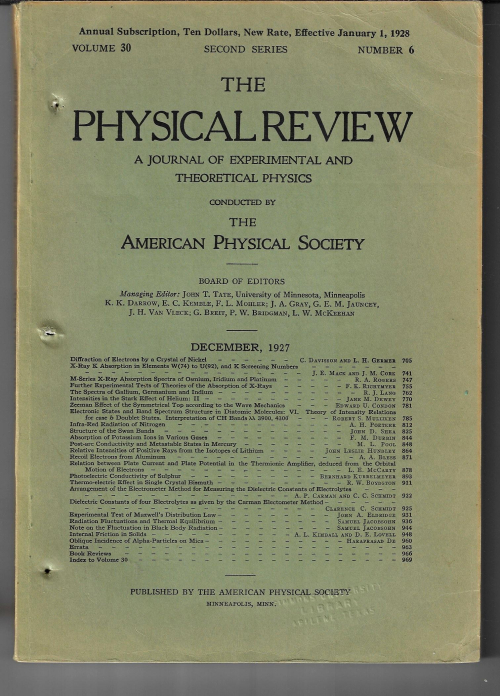 DAVISSON, Clinton Joseph (1881-1959) and L.H. Germer. "Diffraction of Electrons by a Crystal of Nickel", in Physical Review, volume 30, 6, December 1927, pp 705-741, in the issue of pp 705-978. In the original wrappers. The issue with this copy is t hat it was crudely bound in a bad binding; when rescued, though it was left with three binding punch holes (as you can see). The binding did do a good job in protecting the spine and wrappers, but, well... In any event, this nice fresh and punched copy is offered at a fraction of what a nice copy would sell for: $250
DAVISSON, Clinton Joseph (1881-1959) and L.H. Germer. "Diffraction of Electrons by a Crystal of Nickel", in Physical Review, volume 30, 6, December 1927, pp 705-741, in the issue of pp 705-978. In the original wrappers. The issue with this copy is t hat it was crudely bound in a bad binding; when rescued, though it was left with three binding punch holes (as you can see). The binding did do a good job in protecting the spine and wrappers, but, well... In any event, this nice fresh and punched copy is offered at a fraction of what a nice copy would sell for: $250
“Change with wave theory of matter. De Broglie. Einstein. Confirmation by Davidson [sic]”. --in N. Bohr's notebook,in “Complementarity before uncertainty” by Sandro Petruccioli, Arch. Hist. Exact Sci. (2011) 65:591–624. Davisson (mentored by three Nobelists in J.J. Thomson, O. Richardson, and R. Milliken) and George P. Thomson would share the Nobel ten years later in 1937 this brilliant and famous work, "for the experimental discovery of the diffraction of electrons by crystals" (Nobel Prize website).
“It was his due for an experimental result that had showed the wave nature of matter beyond any doubt, as assumed by Louis de Broglie in 1924 and whose solid conceptual foundation lay in the context of Schrödinger’s wave mechanics. In his Nobel Lecture, Davisson attributed to Walter Elsasser, a young student of physics in Göttingen, the merit of having been the first, in 1925, to draw attention to the fact that “beams of electrons like beams of light would exhibit the properties of waves, that scattered by an appropriate grating they would exhibit diffraction”. In short, the experimental demonstration of diffraction had decreed the physical existence of the electron waves.”--Petruccioli (above).
"In the summer of 1926 Davisson attended a meeting of the British Association for the Advancement of Science at Oxford. There he discussed his investigations of the scattering of the electrons with Max Born, James Franck, and others. For the first time he heard in detail about Louis de Broglie’s hypothesis that an electron possesses a wave nature and has a wavelength h/mv, where h is Planck’s constant, m the electron mass, and v the speed of the electron. The Oxford discussions persuaded Davisson that his experimental results were probably due to the effects of de Broglie waves. This interpretation of the earlier Davisson-Kunsman experiments had already been suggested, a year prior to the meeting, by Walter Elsasser, who carried out experiments himself, trying to confirm his point without success. Davisson knew of Elsasser’s suggestion but, failing to find any evidence of a wave phenomenon, dismissed it as irrelevant. Elsasser therefore had no influence on the course of Davisson’s experiments, and it was not until the Oxford conference that Davisson became fully aware of what his experimental results might reveal."
"When Davisson returned from England, he and Germer began a systematic search for some sort of interference phenomenon, and in January 1927 they observed electron beams resulting from diffraction by a single crystal of nickel. The results were in good agreement with de Broglie’s prediction. For his confirmation of electron waves. Davisson shared the Nobel Prize in physics in 1937 with G. P. Thomson, who had independently confirmed electron waves by a different method."--Dictionary of Scientific Biography, pp 597-8.
DSB lists the following as the significant papers for publication in this area in 1927/8, listing the Physical Review paper ahead of NAS and Nature.




Comments